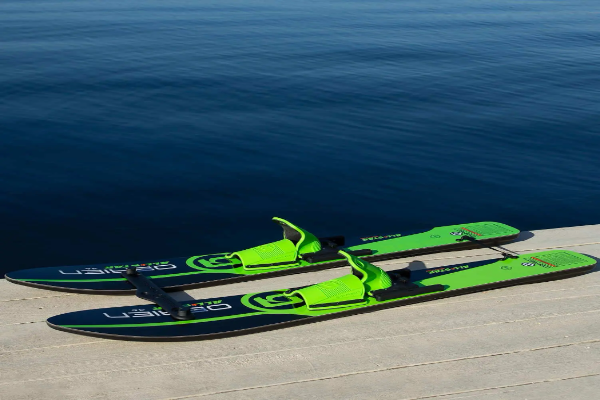Water skiing is a thrilling water sport that combines balance, speed, and agility. Trainer water skis are specifically designed to help beginners learn the basics of water skiing safely and effectively. This comprehensive guide will cover everything you need to know about using trainer water skis, from selecting the right equipment to mastering basic techniques.
Understanding Trainer Water Skis
Trainer water skis are designed to provide stability and ease for beginners. They are wider and more buoyant than regular skis, making it easier to balance on the water. Trainer skis often come with a rope handle attachment to help beginners maintain proper form.
Choosing the Right Trainer Water Skis
- Size and Fit: Ensure the skis fit your weight and height.
- Material: Look for durable materials that can withstand repeated use.
- Features: Consider trainer skis with adjustable bindings and removable trainers for versatility.
Essential Equipment for Water Skiing
- Life Jacket: A well-fitted life jacket is crucial for safety.
- Tow Rope: Use a tow rope with a comfortable handle.
- Boat: A boat with a reliable motor is essential for towing.
- Wetsuit: A wetsuit can provide warmth and protection in colder waters.
Make sure you have the right size and type of trainer water ski for your skill level and weight. You should also wear a life jacket and protective gear such as goggles and gloves.
Preparing for Your First Water Ski Session
- Physical Fitness: Basic physical fitness helps with balance and endurance.
- Stretching: Stretch your muscles to avoid injury.
- Hydration: Drink plenty of water before and after skiing.
- Safety Briefing: Understand the hand signals and safety protocols.
Learning the Basics
- Getting Into Position: Start in the water with your knees bent and skis parallel.
- Holding the Handle: Grip the handle firmly with both hands.
- Body Alignment: Keep your back straight and shoulders aligned.
- Starting: Signal the boat driver when ready.
If you are taking lessons, make sure to follow your instructor’s instructions carefully. They will teach you proper techniques and safety measures.
Getting Up on the Skis
- Boat Speed: The boat should accelerate gradually.
- Balance: Keep your weight centered over the skis.
- Stand Up Slowly: Rise gradually, maintaining a slight bend in your knees.
Keep your body upright and lean slightly forward to maintain balance. Bend your knees slightly and keep your arms straight but not too stiff.
Maintaining Balance and Control
- Body Position: Keep your knees slightly bent and back straight.
- Head Position: Look forward, not down at the skis.
- Weight Distribution: Distribute your weight evenly between both skis.
Turning and Steering
- Leaning: Lean in the direction you want to turn.
- Using the Handle: Move the handle to guide your turns.
- Practice: Start with gentle turns and gradually increase difficulty.
Stopping and Falling Safely
- Letting Go: Release the handle to stop.
- Falling: Try to fall backward or to the side to avoid injury.
- Getting Back Up: Return to the starting position and try again.
Common Mistakes and How to Avoid Them
- Leaning Back: Avoid leaning too far back.
- Tense Arms: Keep your arms relaxed, not rigid.
- Improper Foot Position: Ensure your feet are parallel and shoulder-width apart.
Building Confidence and Skill
- Regular Practice: Consistency is key to improvement.
- Advanced Techniques: Gradually introduce more advanced techniques.
- Seek Guidance: Consider lessons from a professional instructor.
Like any sport, practice makes perfect. The more you ski, the better you will become at it.
Safety Tips for Water Skiing
- Always Wear a Life Jacket: Ensure it is properly fastened.
- Use Hand Signals: Communicate clearly with the boat driver.
- Avoid Crowded Areas: Choose a safe, open area for skiing.
Always be aware of your surroundings and other people in the water. Follow all safety rules and regulations.
Advanced Techniques for Trainer Water Skis
- Crossing the Wake: Learn to cross the boat’s wake smoothly.
- Jumping the Wake: For more advanced skiers, practice small jumps.
- Slalom Skiing: Practice skiing on one ski for a greater challenge.
Before you start skiing, practice standing on the ski and getting used to the balance. Then, try some simple maneuvers such as turning and stopping.
Maintaining Your Equipment
- Regular Inspection: Check your skis and bindings before each use.
- Cleaning: Rinse your skis with fresh water after use.
- Storage: Store your skis in a cool, dry place.
See Also: How to Properly Paddle Board
Conclusion
Using trainer water skis is an exciting way to get into water skiing. With the right equipment, preparation, and practice, you can master the basics and progress to more advanced techniques. Always prioritize safety and enjoy the thrill of gliding across the water.

